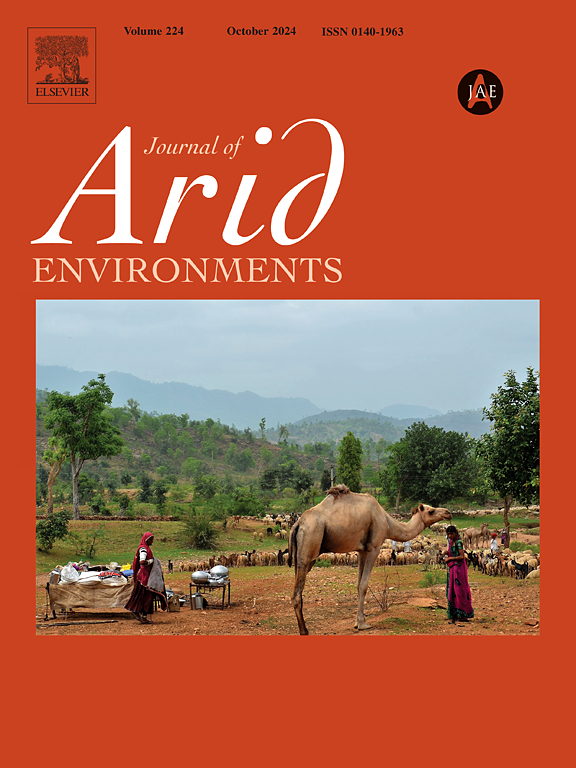Characteristics of the atmospheric dustfall in the Taklimakan hinterland: ground observation and microscopic analysis
IF 2.5
3区 环境科学与生态学
Q2 ECOLOGY
引用次数: 0
Abstract
The physicochemical characteristics of dustfall particles are essential for the in-depth understanding on the aerodynamic processes of aeolian dust and its environmental effects. In this study, we conducted continuous high-frequency sampling of atmospheric dustfall in the Taklimakan hinterland during spring 2022, analyzing particle micromorphology, size distribution, mineral composition, deposition fluxes, and vertical dust characteristics. The results showed that the dustfall particles sampled in the Taklimakan hinterland were mostly micro-aggregates, angular, and subrounded based on the statistical analysis of the Focused Ion Beam Scanning Electron Microscope (FIB-SEM). As determined by the Laser Diffraction Particle Size Analyzer (LDPSA), the dustfall particles were predominately coarse particles, with particles between 20 μm and 80 μm accounting for 83.73 % of the total particle number. Volume proportion of dustfall particles with particle size of 60–150 μm was 72.41 %. Mineralogical analysis of dustfall particles using the Intelligent Scanning Electron Microscope Environmental Particle Analysis System (IntelliSEM EPAS) revealed that calcite was the dominant component (31.15 %), followed by quartz (18.52 %), chlorite (11.84 %), kaolinite (8.11 %), smectite (6.28 %), and illite (5.25 %). Halite was identified as the primary salt component, making up 9.52 % of detected particles. Vertical dust profiles derived by the ground-based Mie-scattering lidar indicated that large amounts of irregular dust floated in the tropospheric atmosphere over the Taklimakan Desert, causing a high depolarization ratio of more than 0.6 within 5 km of the surface. These dust aerosols suspended in the upper air with long periods were attributed to the frequent windblown dust weather over the Tarim Basin in spring, resulting in high ambient particulate concentration and dust deposition.

塔克拉玛干腹地大气降尘特征:地面观测与显微分析
降尘粒子的物理化学特性是深入认识风沙的空气动力学过程及其环境效应的基础。通过对2022年春季塔克拉玛干腹地大气降尘量的连续高频采样,分析了塔克拉玛干腹地大气降尘量的颗粒微观形貌、粒度分布、矿物组成、沉降通量和垂直粉尘特征。聚焦离子束扫描电镜(FIB-SEM)的统计分析结果表明,塔克拉玛干腹地的尘粒以微聚集体、角状和次圆状为主。激光衍射粒度分析仪(LDPSA)测定的降尘颗粒以粗颗粒为主,20 μm ~ 80 μm的颗粒占总颗粒数的83.73%。粒径为60 ~ 150 μm的降尘颗粒体积占比为72.41%。利用智能扫描电镜环境颗粒分析系统(IntelliSEM EPAS)对降尘颗粒进行矿物学分析,方解石为主要成分(31.15%),其次为石英(18.52%)、绿泥石(11.84%)、高岭石(8.11%)、蒙脱石(6.28%)和伊利石(5.25%)。盐的主要成分为岩盐,占检测颗粒的9.52%。地面密散射激光雷达获得的垂直沙尘剖面显示,塔克拉玛干沙漠上空的对流层大气中有大量不规则沙尘漂浮,造成地表5 km范围内的高去极化比大于0.6。这些长时间悬浮在高空的沙尘气溶胶与塔里木盆地春季频繁的风沙天气有关,造成大气颗粒物浓度高、粉尘沉积。
本文章由计算机程序翻译,如有差异,请以英文原文为准。
求助全文
约1分钟内获得全文
求助全文
来源期刊

Journal of Arid Environments
环境科学-环境科学
CiteScore
5.70
自引率
3.70%
发文量
144
审稿时长
55 days
期刊介绍:
The Journal of Arid Environments is an international journal publishing original scientific and technical research articles on physical, biological and cultural aspects of arid, semi-arid, and desert environments. As a forum of multi-disciplinary and interdisciplinary dialogue it addresses research on all aspects of arid environments and their past, present and future use.
 求助内容:
求助内容: 应助结果提醒方式:
应助结果提醒方式:


